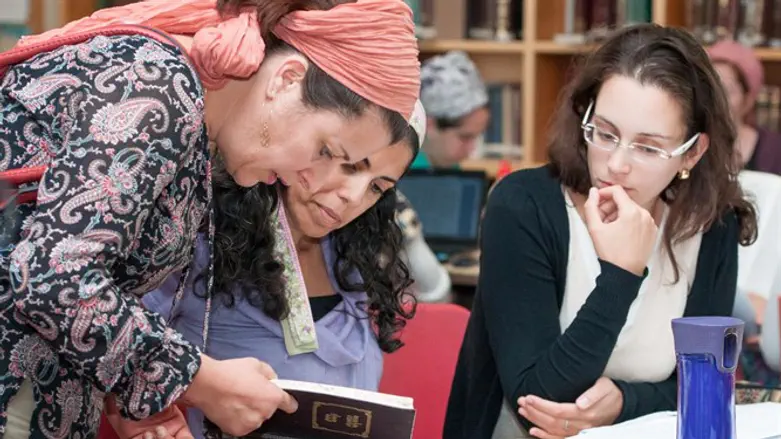
This month's Rosh Hodesh essay is by Sharona Margolin Halickman
Ma’amad Har Sinai, the Revelation at Sinai which we will read on Shavuot, can be looked at as the wedding between God and the Jewish people. We see many similarities to a wedding of a bride and groom.
Before their wedding, the bride and sometimes the groom spiritually prepare themselves by ritually immersing in a mikvah. On their wedding day, both the bride and groom fast in order to disassociate themselves from the physical and direct their consciousness toward the spiritual aspect of marriage. Their love is so strong at that moment, they can’t even think about food.
The stage is set and the guests are surrounding the chupah. The parents of the bride and groom hold candles as they escort them to the chupah. There are instruments playing and voices singing. The bride and groom are shaking and nervous.
Standing under the chupah is the moment of truth where the bride and groom affirm their total commitment to each other. The groom writes and gives the Ketubah, the marriage contract, to his bride showing that this is a long term commitment and he will provide for all of her needs. She accepts the Ketubah as well as the ring which represents the endless bond between husband and wife.
Ma’amad Har Sinai was a similar experience. The Jewish people prepared themselves spiritually. They immersed in the mikvah and fasted. The proof that they immersed in a mikvah: (Shemot 19:10) “Sanctify them today and tomorrow and they shall wash their clothing”. Ramban, quoting the Mechilta comments: When the Torah talks about washing clothing, it is referring to ritual immersion.
Did B’nei Yisrael fast? In Shemot 24:11 we read that “The people had a vision of G-d and they ate and drank”. According to the Zohar, they didn’t eat physical food. Rather, their vision of G-d was their nourishment. They didn’t have to eat physical food. They were fully able to concentrate on the spiritual.
At Mt. Sinai, there was an atmosphere (Shemot 19:16). “There was thunder and lightning, a heavy cloud covered the mountain, the sound of the shofar was very powerful, the people shuddered.” In this verse, we have the lights, the music, the chupah and the people are nervous.
Moshe escorts the Jewish people to greet G-d (Shemot 19:17) – “Moshe brought the people out from the camp towards G-d and they stood at the bottom of the mountain”.
At this point, the mountain was above their heads, literally like a chupah. In the words of the Gemara in Shabbat: G-d covered them with the mountain as though it were an upturned vat.
At this wedding, instead of a ring being given, G-d gave the Jewish people the Torah. The Torah is actually like a ring, it is endless. As soon as we finish reading it, we begin again. The Torah is the endless bond between G-d and the Jewish people.
Even the Ketubah has a parallel in the Torah, the Sefer HaBrit (Shemot 24:7). “Moshe took the book of the covenant and read it in the ears of the people”. According to Chizkuni, the Sefer HaBrit was the list from Sefer Vayikra of G-d’s obligations to the Jewish people and the Jewish people’s obligations to God. The people responded: “All that you have spoken, we will do and we will listen”. The Jewish people expressed their commitment to God, the Torah and the mitzvot.
Every Jewish wedding, Ashkenazi or Sephardi, small or large, lavish or simple has something in common – its similarity to Ma’amad Har Sinai. As the Jewish people committed themselves to G-d at Sinai, so too do bride and groom commit themselves to each other under the chupah.
After the first luchot, tablets, were broken Moshe ascended Mt. Sinai for another 40 days and nights. Then G-d gave the second set of luchot. The way that the luchot were given the second time was different than the first. There was no thunder and lightning. Although this revelation was far simpler, it was more lasting—the second luchot, unlike the first, were never broken.
This reminds me of the simple weddings which have taken place over the past few weeks when large gatherings of people were prohibited. They were in backyards or on street corners instead of fancy halls yet you could feel the deep spirituality and love between the bride and groom.
This sends us a message that a wedding should have a certain amount of humility in both the way that the wedding and celebration are conducted as well as in the way that the bride and groom commit themselves to each other.
The breaking of the glass under the chupah evokes Moshe’s breaking of the tablets and shows us how fragile this relationship can be.
On Shavuot, when we read the Ten Commandments, the Aseret HaDibrot, we will be simulating the moment of Sinai. When we witness a wedding ceremony, that moment at Har Sinai is re-enacted once again.
Matan's Edythe Benjamin Torah Essay is in memory of חיה בת שלמה, beloved mother of Barbara Hanus.
Matan is an innovative institution located in Jerusalem an ddedicated to furthering women's Torah study, paving the way for them to learn Talmud, Tanakh and Halakha at the highest levels.
Sharona Margolin Halickman is a graduate of the Bellows Eshkolot Educators Institute for Tanakh and Jewish Studies (‘19). She is currently a fellow at Hilkhata - the Advanced Institute for Halakhic Studies at Matan. Sharona is the founder of Torat Reva Yerushalayim and teaches at Midreshet Torah V’Avodah.